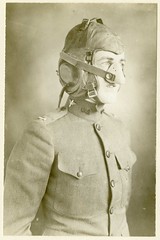Headquarters, District of Texas
Office of Surgeon in Chief,
Austin, Texas, March 27th 1868
Dear Doctor:
I have received this morning the first “Return of Wounds and Injuries received in action,” that has presented itself, since I entered upon my duties in this District. It is from McElderry at Fort Griffin, who accompanied a scouting party in an attack upon some Comanches, near old Fort Phantom Hill. The matter is one of interest to you, I trust, inasmuch as a considerable number of Indian bows, arrows and shields were captured. The Comanches, fourteen in number, upon being surprised, “bifurcated,” – one party makings its escape, and all the other party, seven in number, falling victim. As the soldiers did not trouble themselves to take the Indians to camp on litter, but left them dead on the spot, I am in hopes that McElderry may be able to obtain their crania. I have written to him about the desirability of augmenting the Army Med. Museum with such trophies. Three soldiers were wounded.
Another Indian fight has also just occurred in the vicinity of
Fort Mason [illegible] and eight Texas Rangers, organized under the command of the Commanding Officer at Fort Mason, attacked twenty two (?) Indians, killed two of the number, and captured twelve horses. I do not believe that any medical officer of the Army was present.
These skirmishes are probably preludes to continued and extensive activity and blood-drawing, in the vicinity of the new frontier Cavalry post, and justify my recommendation that at least two medical officers should be on duty at each large military station in the new line of defence, extending from the Red River to the Rio Grande. Every large scouting party, dispatched from a fort on such an expedition as McEdlerry took part in, should be provided with a surgeon. Gen. McParlin assented to my views some time since, very readily, and orders were issued supplying Richardson, Griffin, (Burhham when established,) Concho, McKavitt etc with two medical officers. I may think it necessary to give even a third “saw-bones” to one or two of the more important commands.
I beg that you will bring this matter favorably to the attention of the Surgeon General and General Crane, as they may be surprised to see two or three medical officers reported to be on duty at a single post. Some of the posts are to be garrisoned by eight companies.
I am on the alert, also, with reference to the matter of scurvy in the frontier posts referred to. Although the troops have not reached there yet, I have already put most of the post surgeons on their guard, and have urged them to persuade company commanders to cultivate gardens, and provide their men with as much fresh vegetable food as possible. The commissary at New Orleans has promised to provide the new posts with larger amounts of canned vegetables, so that their sale may be extended to the enlisted men, and not limited to officers, after their present custom.
Your letter concerning the acquisition of curiosities for the Museum from frontier officers has received my careful attention. It is probable that in course of the summer I shall have opportunity of personally urging the medical officer and others in my District, to second your efforts ably. From what Gen. Reynolds has told me I think that I may be one of a party of his staff to visit all of the frontier posts. He sees the importance of the duty, in my case, especially if I am to occupy my present position for a term of years! – for by personal inspection of the posts, the country, and the men I should have a much better basis for official work than I now have. Present my kindest regards to all, & let me hear from you.
Yours truly,
Warren Webster
Col. George A. Otis, etc etc.



























